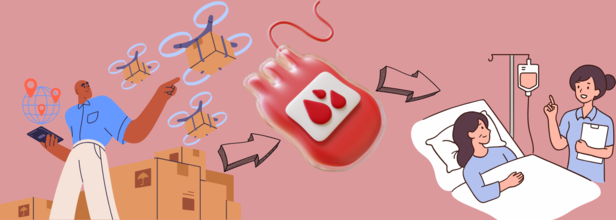- Health Conditions A-Z
- Health & Wellness
- Nutrition
- Fitness
- Health News
- Ayurveda
- Videos
- Medicine A-Z
- Parenting
- Web Stories
Drone Delivery For Blood In India Can Revolutionize Healthcare, Finds ICMR Report

Credits: Canva
In what could be a gamechanger for emergency healthcare, drones are proving faster and in some cases, more reliable than ambulances when it comes to delivering life-saving medical supplies like blood. A recent study by the Indian Council of Medical Research (ICMR) highlights how this technology is stepping in when every second counts.
A 15-Minute Lifeline Over 35 km
In a pilot experiment conducted in 2023, a drone carried blood bags from GIMS Hospital in Greater Noida to Lady Hardinge Medical College in Delhi’s Connaught Place. It was a 35-kilometre journey completed in just 15 minutes. For comparison, a regular ambulance would have taken over an hour.
Though the experiment was carried out last year, ICMR published its detailed findings in June 2024 in a report titled, Adopting Drone Technology for Blood Delivery: A Feasibility Study to Evaluate Its Efficiency and Sustainability.
The conclusion? Drones are not just fast, but they’re also safe and efficient for delivering blood in emergencies.
Why Blood Delivery by Drone Is So Complex
Using drones for healthcare is not a new idea, vaccines and other supplies have been flown into remote areas before. But transporting blood is much more sensitive.
Blood components like red blood cells, plasma, and platelets need strict temperature control and careful handling to maintain their quality. Unlike organs, which are transported in rare cases, blood has to be moved more frequently and reliably.
The ICMR study showed that with proper temperature-controlled packaging and special gel packs, blood can be transported without damage.
Drones used in the trial carried 4 to 6 blood bags and followed India's aviation safety guidelines. Importantly, no significant damage, like hemolysis was found in the blood after the flight. The quality of the transported blood remained safe, and any minor changes were similar to those seen in van transport.
Drones vs. Ambulances: Why It Matters
This isn't the first time drones have proven their worth. A few months earlier, a drone in Haryana slashed delivery time for eye tissues by 70%, flying 38 km from Sonipat to Jhajjar in just 40 minutes, a road trip that usually takes over two hours.
In cities like Delhi, drones have also been used to control mosquito-borne diseases. It’s clear that drones are quickly expanding their role from novelty to necessity.
But the ICMR also notes: more scientific evidence is needed before drones can be widely adopted for medical deliveries. The idea may be promising, but it’s not without its hurdles.
What Are The Challenges Ahead
Even though the results are encouraging, many challenges remain. Regulatory restrictions, weather conditions, battery limitations, safety concerns, and costs are big roadblocks. Drones must also be seamlessly integrated into existing healthcare and air traffic systems.
Blood transport, in particular, requires vibration validation, consistent temperature control, and real-time monitoring; any lapse could lead to damage or contamination.
A pan-India regulatory framework is essential for scaling up. India’s vast and varied landscape, from mountains to dense urban centres presents its own set of complications. As a 2025 Journal of Transport and Public Health study pointed out, poor rural blood bank infrastructure and high costs could limit scalability.
A Global Trend
India isn’t alone in this journey. Rwanda was the first to adopt a national drone medical delivery system back in 2016. The UK also plans to launch nationwide drone medical deliveries by 2026 after successful NHS trials.
India has already taken steps in this direction. Under the i-DRONE initiative launched in 2021, ICMR carried out successful drone-based deliveries of vaccines and medical kits in the Northeast. Now, the focus is shifting to more critical and sensitive deliveries like blood.
You Are Much Less Likely To Get Opioid Prescriptions For Lower Back Pain Than Before- Is Healthcare Getting Better?

(Credit-Canva)
Emergency rooms are handing out significantly fewer opioid prescriptions to people experiencing lower back pain. Researchers reported in the Annals of Emergency Medicine on July 12 that the rate of opioid prescriptions for back pain in ERs dropped by more than half between 2016 and 2022.
Dramatic Decline in Opioid Prescribing
Just a few years ago, in 2016, almost one out of every three visits to the ER for back pain ended with a prescription for opioid painkillers. But by 2022, that number had fallen dramatically to just over one in ten visits. This big drop means that doctors are learning from the available information and changing the way they practice medicine, especially as more people become aware of the widespread problems caused by opioid addiction. It's a positive sign that medical professionals are actively working to curb the opioid crisis.
Understanding the Study and Patient Experience
To figure this out, researchers looked at records from nearly 53 million ER visits for low back pain that happened between 2016 and 2022. These records were gathered by a national health statistics centre. The study found that when people went to the ER for back pain, they were usually in a lot of discomfort, rating their pain at more than 7 out of 10. On average, they had to wait about 37 minutes before a doctor saw them and spent around four hours in the emergency room getting treatment.
Why Opioid Usage Is Risky For Patients
A 2023 study even found that opioids may not be as effective for back pain. Published in the JAMA network, a 2023 study conducted a trial on those who were experiencing back pain. The trial involved 347 adults who had been experiencing pain for up to 12 weeks. Everyone in the study received standard care, which included reassurance, advice to avoid bed rest, and encouragement to stay active. Half of the participants also received a combination of oxycodone and naloxone (an opioid), while the other half received a placebo (a dummy pill).
The study also revealed that while side effects were similar for both groups, there was a significant difference in the risk of opioid misuse. One year later, 20% of the participants who took opioids were at risk of misusing them, compared to only 10% of those who received the placebo. This suggests that even for short-term pain relief, opioids carry a greater risk of future misuse.
NSAIDs Emerge as Preferred Treatment
Now, when you go to the ER with low back pain, nonsteroidal anti-inflammatory drugs, often called NSAIDs (like ibuprofen), are the most common painkillers prescribed. They're given to almost 29% of patients. It's not just about prescriptions either; fewer patients are actually given opioids while they are being treated in the ER. That number went down from 35% of cases in 2016 to less than 25% by 2020, showing a clear shift away from immediate opioid use during emergency care for back pain.
Next Issues People Must Tackle
Even though there's good progress with reducing opioids, ER doctors still have some areas where they could improve how they treat back pain. For example, many patients with back pain are still getting X-rays that they don't really need. In 2022, about 37% of patients had an X-ray, which is pretty much the same as in 2015. In fact, in 2021, almost 44% of cases involved an X-ray, which was the highest rate. It's tough to get this number down because deciding whether to order an X-ray can be complicated and depends on what both the doctor and the patient think is best.
New Hope For Heart Transplants: Researchers Look At Methods That Could Preserve Heart For Longer Duration

Credits: Canva
In a major step forward for heart transplants, doctors at two leading U.S. hospitals — Duke University and Vanderbilt University — have developed simpler and potentially life-saving methods to recover hearts from donors whose hearts have already stopped beating. Their research, published Wednesday in the New England Journal of Medicine, could expand the pool of viable donor hearts, especially for babies and young children who often face the longest waits and highest risks.
Rethinking Heart Donation After Cardiac Death
Most donor hearts used for transplants come from people who are declared brain-dead but whose hearts are still beating. In these cases, organs are kept alive on a ventilator until they’re retrieved. However, another type of donor, someone whose heart has stopped after life support is withdrawn, often goes unused. These are known as DCD (donation after circulatory death) donors.
While DCD organs are commonly used for kidneys and livers, using their hearts is more complicated. Once the heart stops, oxygen is cut off, and even a short delay before retrieval can make the heart unusable. That’s why new methods are needed to safely assess and preserve these hearts for transplant.
Controversial and Costly Options
One current method to save DCD hearts is called normothermic regional perfusion (NRP). It involves restarting blood flow to the heart and other organs, but only after clamping off the arteries leading to the brain. While effective, this technique is ethically controversial because it reintroduces circulation after death, which some hospitals do not allow.
Another alternative is to use high-tech machines to “reanimate” the heart outside the body, pumping it with blood and nutrients to keep it functioning until it reaches the transplant hospital. These machines, however, are expensive and complex, and not suitable for infants, whose small hearts can’t be supported by the equipment.
Simpler, Safer Methods Emerging
In response to these challenges, the Duke team developed a new, less invasive technique. Instead of reanimating the heart or using costly machinery, they simply removed the heart and briefly tested it by pumping blood and oxygen through it on a sterile table. This short test, done without restoring full-body circulation, was enough to confirm the heart was still viable.
The method was first tested on piglets and then used in a real case: a 1-month-old infant at another hospital became a donor, and Duke surgeons transported the heart to save a 3-month-old baby. The retrieval took just minutes and the heart showed clear signs of life , “it’s pink, it’s beating,” said Dr. Joseph Turek of Duke.
Meanwhile, Vanderbilt’s team took an even more streamlined approach. They simply flushed the heart with a cold, nutrient-rich solution, similar to what’s done for brain-dead donors, before transporting it. “You don’t necessarily need to reanimate the heart,” said Dr. Aaron Williams, the lead author of the Vanderbilt study. The hospital has already completed about 25 such heart transplants using this method.
A New Chance for Patients Waiting in Line
The need for more donor hearts is urgent. Each year, around 700 children in the U.S. are added to the transplant waiting list, and nearly 20% of them die before receiving a new heart. Infants are especially vulnerable due to their small size and limited donor pool.
Last year, 43% of organ donors were DCD, yet only 793 out of 4,572 heart transplants came from this group. That’s a huge gap many experts hope to close.
Brendan Parent, a transplant ethics expert at NYU Langone Health, called the research “promising and essential.” He added, “Innovation to find ways to recover organs successfully after circulatory death is key to reducing the organ shortage.”
As these new techniques continue to be tested and refined, they may offer fresh hope to thousands of patients, especially the youngest ones, waiting for a second chance at life.
Understanding Soft Tissue Sarcoma: When Should You Be Concerned About A Lump?

Credits: Canva
Soft tissue sarcoma (STS) is a rare type of cancer that can quietly grow in the connective tissues of the body—such as fat, muscles, nerves, blood vessels, or beneath the skin. Although it represents less than 1% of all cancers, its quiet nature often leads to late detection, making treatment more challenging.
When a Lump Deserves Closer Attention
It’s common for people to dismiss a lump under the skin as harmless—perhaps a cyst or muscle knot. However, some features can indicate something more serious. You should consult a doctor if the lump is:
- Larger than 5 cm (roughly the size of a golf ball),
- Located deep under the muscle,
- Firm and doesn’t move easily,
- Or steadily increasing in size.
Pain is not always present in the early stages. Often, discomfort only appears when the lump starts pressing against nearby nerves or tissues. Unfortunately, the absence of pain can lead to delayed diagnosis.
*Aryan’s Story: The Power of Acting Quickly
Twelve-year-old a=Aryan's parents noticed a firm swelling on his thigh. At first, they thought it was a sports injury as he had a recent fall while playing football. Since it didn’t hurt, they waited. But the lump continued to grow. When Aryan finally underwent imaging, doctors diagnosed him with a high-grade synovial sarcoma.
It was a heart-wrenching moment no parent is ready for. Yet, prompt medical attention changed everything. Aryan received surgery, chemotherapy, and radiation over several months. Now, two years later, he’s cancer-free and back on the football field. His story is a powerful testament to timely diagnosis, expert medical care, and quiet strength.
Diagnosing STS: A Careful, Coordinated Approach
Diagnosing soft tissue sarcoma involves multiple steps:
- MRI or CT scans to assess the tumour’s size and how far it has spread.
- A biopsy, performed or guided by a cancer specialist, to avoid compromising future surgery.
- PET-CT scans in aggressive cases to check if the cancer has spread.
It’s crucial to involve a specialized sarcoma team—surgical, medical, and radiation oncologists—for accurate diagnosis and an effective treatment plan.
Treatment: Experience Matters
The main treatment for STS is surgery to remove the tumor completely. Depending on the type and grade of the sarcoma, doctors may recommend radiation or chemotherapy before or after the operation.
For advanced or metastatic sarcomas, new therapies such as targeted drugs and immunotherapy are sometimes used. Research shows that outcomes are significantly better when patients are treated at specialised sarcoma centres.
Don’t Ignore a Suspicious Lump
Most lumps are harmless. But overlooking a cancerous one could be life-changing. If a lump is growing, unusual, or doesn’t go away—get it checked.
Golden rule: “If it’s growing, deep, or persistent—see a doctor.”
*Names have been changed to protect the identity of the individual.
© 2024 Bennett, Coleman & Company Limited

